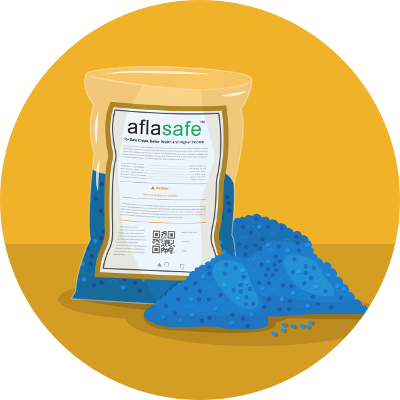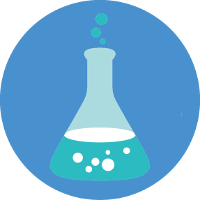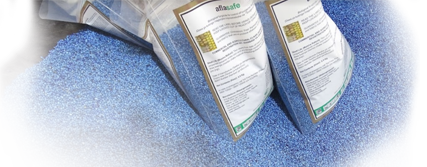 Aflasafe is nourished by deep roots in over a decade-and-a-half of research and development. It is not an off-the-shelf solution – each country has its own made-to-measure product. These are created by collecting thousands of samples of fungi from locations across the country, and finding the ones that are best at cutting aflatoxin and can never produce the toxin themselves. Each version of Aflasafe, combining the four top local champions, is developed over several years of meticulous testing, checking its performance in different locations and in different conditions. This careful, tailored research process gives Aflasafe a solid foundation in science, while into the future the R&D team will provide ongoing support and monitoring to continually ensure and improve Aflasafe’s effectiveness.
Aflasafe is nourished by deep roots in over a decade-and-a-half of research and development. It is not an off-the-shelf solution – each country has its own made-to-measure product. These are created by collecting thousands of samples of fungi from locations across the country, and finding the ones that are best at cutting aflatoxin and can never produce the toxin themselves. Each version of Aflasafe, combining the four top local champions, is developed over several years of meticulous testing, checking its performance in different locations and in different conditions. This careful, tailored research process gives Aflasafe a solid foundation in science, while into the future the R&D team will provide ongoing support and monitoring to continually ensure and improve Aflasafe’s effectiveness.
 The idea of using friendly fungi to outcompete the aflatoxin producers was first tried by the Agricultural Research Service of the United States Department of Agriculture (USDA–ARS). The research and development efforts to adapt and refine this concept in Africa were led by the International Institute of Tropical Agriculture (IITA), working with USDA–ARS and many national partners in countries across the continent. A large number of individual projects came under the Aflasafe umbrella – for more on many of these see below.
The idea of using friendly fungi to outcompete the aflatoxin producers was first tried by the Agricultural Research Service of the United States Department of Agriculture (USDA–ARS). The research and development efforts to adapt and refine this concept in Africa were led by the International Institute of Tropical Agriculture (IITA), working with USDA–ARS and many national partners in countries across the continent. A large number of individual projects came under the Aflasafe umbrella – for more on many of these see below.
IITA’s research on aflatoxin
R&D projects
AgResults Aflasafe incentivization in Nigeria
Years: 2013–2019
Countries: Nigeria
Funders: Australia/AUSAID, Bill and Melinda Gates Foundation, Canada/Finance Canada, United Kingdom/DFID, United States/USAID through Deloitte Consulting LLC on behalf of the World Bank
Feed the Future Malawi Improved Seed System and Technologies (Aflasafe Component)
Years: 2014–2018
Countries: Malawi
Funders: USAID (prime sponsor)
APPEAR project on biocontrol and policy in EAC
Years: 2013–2016
Countries: Burundi, Ethiopia, Kenya, Rwanda, South Sudan, Tanzania, Uganda
Funders: USAID East Africa Regional Mission
Mitigation of aflatoxin in maize and groundnuts in Mozambique
Years: 2013–2016
Countries: Mozambique
Funders: USAID-Moz and USDA-FAS
Mitigation of aflatoxin in maize and groundnuts in Zambia
Years: 2012–2015
Countries: Zambia
Funders: USAID
Expansion of biological control to manage aflatoxin in maize and groundnut using regionally-adapted beneficial fungi in Eastern and West Africa
Years: 2012–2014
Countries: Ghana, Mali, Nigeria, Tanzania, Other countries in West, East and Southern Africa
Funders: Partnership for Aflatoxin Control in Africa (PACA) through Meridien Institute
Aflatoxin control in maize through aflatoxin-resistant variety breeding and other aflatoxin management methods
Years: 2010–2013
Countries: Nigeria
Funders: Nestlé
Expanding Nigeria’s exports of sesame seeds and sheanut/butter through improved SPS capacity building for private and public sector
Years: 2011–2013
Countries: Nigeria
Funders: Nigerian Export Promotion Council (NEPC) through WTO/STDF
Cost effective, farmer- and environment-friendly biocontrol of aflatoxin in chili peppers (Capsicum spp.)
Years: 2012–2013
Countries: Nigeria
Funders: Deutsche Gesellschaft für Internationale Zusammenarbeit (GIZ)
Development and commercialization of biological control of aflatoxins in Kenya and Nigeria
Years: 2010–2013
Countries: Kenya, Nigeria
Funders: Bill & Melinda Gates Foundation
Biological control of aflatoxins in maize for enhanced food safety and income in Burkina Faso
Years: 2010–2013
Countries: Burkina Faso
Funders: Austrian Development Agency (ADA)
Demonstrating aflatoxin biocontrol technology in Senegalese groundnut fields
Years: 2010–2013
Countries: Senegal, The Gambia
Funders: African Agricultural Technology Foundation (AATF)
Mycotoxin contamination in Rwanda: quantifying the problem in maize and cassava in households and markets, and sensitization of targeted stakeholders based on a cost-benefit analysis
Years: 2013–2013
Countries: Rwanda
Funders: USAID-Rwanda
Mycotoxin contamination in Tanzania: quantifying the problem in maize and cassava in households and markets
Years: 2012–2012
Countries: Tanzania
Funders: USAID – AfricaRising program
Novel integrated strategies for worldwide mycotoxin reduction in the food and feed chains
Years: 2009–2012
Countries: Tanzania
Funders: European Union
CADP initiative on aflatoxin management in the maize value chain
Years: 2011–2012
Countries: Nigeria
Funders: Commercial Agriculture Development Project of the Federal Ministry of Agriculture and Water Resources (CADP)
 Aflasafe is nourished by deep roots in over a decade-and-a-half of research and development. It is not an off-the-shelf solution – each country has its own made-to-measure product. These are created by collecting thousands of samples of fungi from locations across the country, and finding the ones that are best at cutting aflatoxin and can never produce the toxin themselves. Each version of Aflasafe, combining the four top local champions, is developed over several years of meticulous testing, checking its performance in different locations and in different conditions. This careful, tailored research process gives Aflasafe a solid foundation in science, while into the future the R&D team will provide ongoing support and monitoring to continually ensure and improve Aflasafe’s effectiveness.
Aflasafe is nourished by deep roots in over a decade-and-a-half of research and development. It is not an off-the-shelf solution – each country has its own made-to-measure product. These are created by collecting thousands of samples of fungi from locations across the country, and finding the ones that are best at cutting aflatoxin and can never produce the toxin themselves. Each version of Aflasafe, combining the four top local champions, is developed over several years of meticulous testing, checking its performance in different locations and in different conditions. This careful, tailored research process gives Aflasafe a solid foundation in science, while into the future the R&D team will provide ongoing support and monitoring to continually ensure and improve Aflasafe’s effectiveness. The idea of using friendly fungi to outcompete the aflatoxin producers was first tried by the Agricultural Research Service of the United States Department of Agriculture (USDA–ARS). The research and development efforts to adapt and refine this concept in Africa were led by the International Institute of Tropical Agriculture (IITA), working with USDA–ARS and many national partners in countries across the continent. A large number of individual projects came under the Aflasafe umbrella – for more on many of these see below.
The idea of using friendly fungi to outcompete the aflatoxin producers was first tried by the Agricultural Research Service of the United States Department of Agriculture (USDA–ARS). The research and development efforts to adapt and refine this concept in Africa were led by the International Institute of Tropical Agriculture (IITA), working with USDA–ARS and many national partners in countries across the continent. A large number of individual projects came under the Aflasafe umbrella – for more on many of these see below.



 AgResults.pdf
AgResults.pdf





